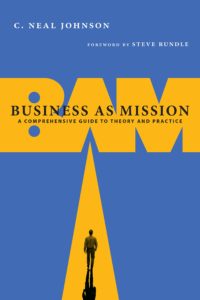Definition of Business as Mission (BAM)
 One of the popular terms today, when it comes to mission strategy, is called Business as Mission (BAM). C. Neal Johnson in his book Business as Mission: A Comprehensive Guide to Theory and Practice, broadly defines Business as Mission (BAM) as a for-profit commercial business venture that is Christian-led, intentionally devoted to being used as an instrument of God’s mission (missio Dei) to the world, and is operated in a cross-cultural environment, either domestic or international (pp.27-28). A similar meaning, written in different words by Mats Tunehag goes like this “Business as Mission is about real, viable, sustainable and profitable businesses, with a Kingdom of God purpose, perspective and impact; leading to transformation of people and societies spiritually, economically, socially, and environmentally- to the glory of God.”
One of the popular terms today, when it comes to mission strategy, is called Business as Mission (BAM). C. Neal Johnson in his book Business as Mission: A Comprehensive Guide to Theory and Practice, broadly defines Business as Mission (BAM) as a for-profit commercial business venture that is Christian-led, intentionally devoted to being used as an instrument of God’s mission (missio Dei) to the world, and is operated in a cross-cultural environment, either domestic or international (pp.27-28). A similar meaning, written in different words by Mats Tunehag goes like this “Business as Mission is about real, viable, sustainable and profitable businesses, with a Kingdom of God purpose, perspective and impact; leading to transformation of people and societies spiritually, economically, socially, and environmentally- to the glory of God.”
In these two, but a related definition of BAM above, it boils down to this concept: real or authentic business can be a mission strategy for the fulfillment of the Great Commission. Doing business is more than just meeting the “economic” need of the people, which is, certainly, a bottom line. But, it goes beyond material and financial goals.
Practical Aspect of Business as Mission (BAM)
The theoretical aspect of Business as Mission deals with definitions. It also discussed foundational beliefs and answers the “whys.” The practical aspect deals with all the “hows” and the implementations of this mission strategy.
In contrast to other “theorists” on Business as Mission, C. Neal Johnson produced a lengthy portion on the practical aspect of BAM. It is all about details for the strategy to be successful. Johnson admitted that “regardless of how much commitment, passion, and resourcefulness the would-be BAMers brings, BAM will often be unsuccessful without the convergence of other forces”(p.190). He mentioned these forces as a summary of the “spiritual” and practical necessities of doing Business as Mission:
(1) the power, resources and creativity of the Holy Spirit working within us; (2) the God-instilled gifts, the experiential business and trade skills, and the human and financial capital necessary to launch the selected business; (3) an understanding of the cultural, political and economic context in which the business is conducted, the context’s mission history and the mission methods best suited for that setting; and (4) proper and adequate preparation, training and planning for the many demands, roles and functions required by BAM (p.190).
Johnson is aware that there is two important major aspect of implementing this mission strategy: spiritual and technical. The spiritual aspect is the guiding power of the Holy Spirit. The faith and spirituality of the business owners and personnel. The technical aspect is the broad details of doing business.
